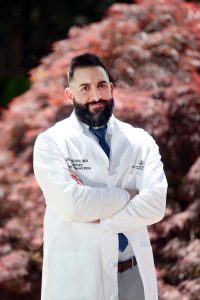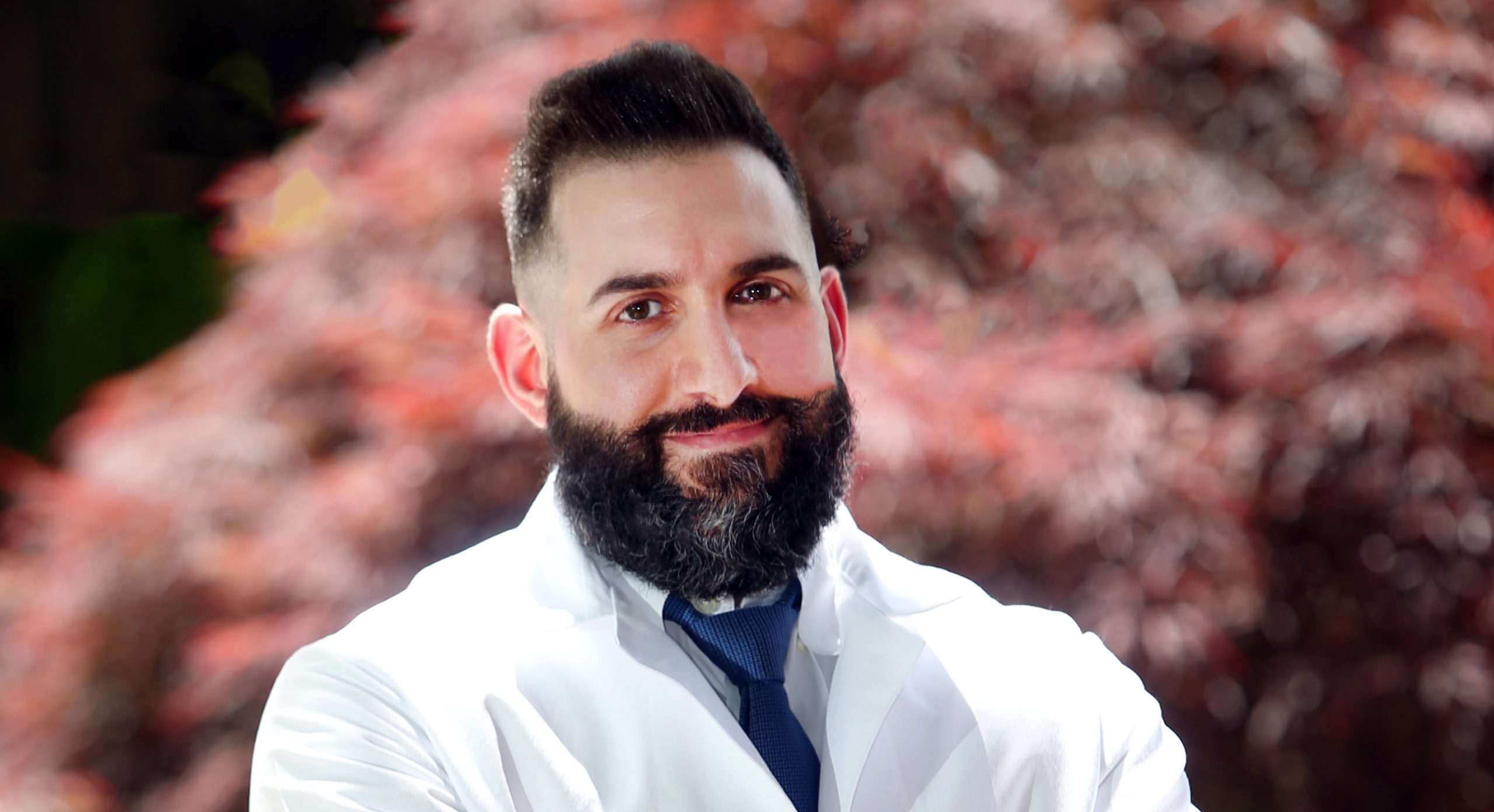Elie Sader, M.D.
By Margaret Burke / Photography by STAN GODLEWSKI
Elie Sader, M.D., a pain neurologist, began serving patients at Saint Francis Hospital in July 2021 after completing his fellowship in Interventional Pain Management at New York University. He is board–certified in both Neurology and Pain Management. Since starting at Saint Francis, Dr. Sader has implemented a Pain Neurology Clinic. The clinic is a subdivision of the neurology department. This is a fairly unique model for a pain management service. Dr. Sader explains that the majority of pain management services are run by anesthesiologists or, less frequently, by physiatrists (Physical Medicine and Rehabilitation). This Pain Neurology Clinic is a first for Saint Francis and for Connecticut. Until now, the closest neurology-driven pain services available were in Boston or New York City.

The Pain Neurology Clinic is multidisciplinary. Dr. Sader works with a registered nurse, physician assistants (PAs), advanced practice registered nurses (APRNs), nurse practitioners, medical assistants, and a surgical scheduler. He explains that about half of the patients he sees in the clinic come to him for control of headaches, and the other half come for pain management “of everything else – neck pain, back pain, sciatica, and various types of joint pain.”
Dr. Sader believes in an integrated approach to treating pain. “It is really uncommon to have a patient who has only one pain generator in their body,” he says. A patient may initially come in for treatment of one type of pain, but they are happy to discover that he can treat their other sources of pain, too. Dr. Sader explains that after obtaining a complete history and physical, and performing diagnostic tests such as imaging studies (MRI, X-ray), or nerve conduction studies, he will have a discussion with the patient about treatment options and realistic expectations for pain control. Together, he and the patient prioritize which pain problem to tackle first, and which approach (medication, procedure, conservative) best aligns with the patient’s wishes.
Dr. Sader feels this integrated model makes more sense than a person seeing different doctors for pain in different parts of their body. He also thinks this model increases safety for the patient. Whenever a patient is seeing multiple providers for the same problem, there is a risk of miscommunication between providers, and there can be differences in how each provider approaches pain management, which could conflict, and overlapping prescriptions for medications in the same class can create problems for the patient that no single provider takes ownership over.
Patients, of course, see other specialists to manage their disease(s), but through the Saint Francis Pain Neurology Clinic, Dr. Sader is the point person for the pain management piece of the disease. He gives the example of a patient with arthritis pain. The patient sees a rheumatologist who manages medications to control the progression of arthritis, and perhaps an orthopedic doctor who may have offered the option of a joint replacement down the line. However, the arthritis has already caused joint damage and pain. Dr. Sader sees the patient specifically to address the joint pain and any other type of pain the patient might have.
Dr. Sader’s approach to pain management is multi-faceted. He uses three main modalities, often in combination “because doing just one of these is not enough, and they tend to have a synergistic effect.” They are:
Medications: There are many options depending on the type of pain. Some patients want to avoid or minimize medication use out of concern for drug side effects, or simply due to the inconvenience of having to take pain medications daily.
Interventional procedures: There are various types of pain-relieving procedures including nerve blocks, trigger point injections in muscles, joint injections with a combination of corticosteroids to reduce inflammation and a local anesthetic to reduce pain, neurotomy procedures to “burn” specific nerves that cause pain, spinal injections/epidurals to reduce inflammation around a herniated disc, and botulinum toxin injections.
Conservative approaches: Physical Therapy, massage, acupuncture.
He explains that the while the interventional procedures reduce pain, the effects don’t last forever. However, the period of improved pain control allows patients to participate in physical therapy or other conservative approaches providing a more sustained benefit. For example, a herniated disc causing nerve root compression and sciatic pain will typically respond well to an epidural steroid injection (which is a type of spinal injection). However, the epidural itself is not curing the disease. It is lessening the pain (tremendously in most cases) for several months up to a year, during which time the patient will be able to better participate in physical therapy, which will lead to less compression of the affected nerve root with time. Patients are sometimes unable to participate in PT due to the extent of pain they already have (which is only worsened by PT at times), and the spinal injection alone is not sufficient to lead to permanent relief, however, the combination of the two leads to the best model to proper healing.
The Road to Hartford
Dr. Sader majored in neuroscience for his undergraduate studies at McGill University in Montreal, Canada. There, his focus was mainly on research examining at the molecular level how different medicines worked and how the circuitry in the brain conveys emotions and mental states. He went on to complete graduate studies in neuroscience at the University of Oxford in England. It was there that he developed his interest in clinical neuroscience and the desire to pursue medicine. He completed medical school at The University of Toronto.
This was followed by a 4-year neurology residency at Boston University Medical Center. “Here,” he says, “I was lucky enough to have my first exposure to pain management.” He says he gravitated toward this specialty “because you are able to help a patient on the spot as opposed to just diagnosing their disease and referring them to another provider without having any ability to change the disease course.”
Because of his passion for pain management, Dr. Sader pursued the fellowship in Interventional Pain Management at New York University. He explains that the majority of physicians accepted into the program are anesthesiologists with only a few spots available for other subspecialties such as neurology.
Dr. Sader was thrilled to now be calling the greater Hartford area home, where he is able to treat patients in an underserved region. He enjoys the area very much and likes being close to his friends in Boston and New York.
Dr. Sader’s dual training in neurology and pain management has proven to be a great benefit to his patients. While traditionally Neurologists diagnosis patients and are excellent at finding the “lesion” or culprit for a given symptom or pain disorder, it’s less common for a Neurologist to have also undergone procedural training in residency.. In contrast, most physicians who specialize in pain management begin seeing patients once they are diagnosed and referred from another physician and they are ready for treatment. Dr. Sader’s specialized dual training allows him to serve the patient in a multifaceted way. Having gained both the neurology detective skills and the anesthesiology procedural toolkit, he is able to integrate both diagnosis and treatment, which directly feed into each other, so that if one treatment doesn’t work, he is able to use that feedback directly to guide his diagnosis and subsequent treatments, ultimately providing a significantly more efficient and satisfying patient experience.
Advances and Challenges in Pain Medicine
There have been several advances made in the area of pain management over the last few years. One of the biggest is the availability of a new class of medications to treat migraine headaches. They are called CGRP inhibitors. CGRP stands for calcitonin gene-related peptide, which is a protein in the brain involved in transmitting pain sensations. Dr. Sader explains that these medications work well, have fewer side effects than the classic migraine medications, and are available to be taken by mouth, so they are convenient, too.
There are also advances in interventional procedures, but they are still in the experimental stages, so they are not yet available through the Pain Neurology Clinic. These include “regenerative therapies,” where rather than injecting a joint with a combination of steroid and local anesthetic, components such as stem cells are injected into the joint instead to repair the damage, however further studies are needed to prove their efficacy and cost-effectiveness.
The opioid epidemic has continued to provide challenges as well as opportunities in pain management. Dr. Sader explains that opioids are often not the best option for treating chronic pain conditions, but in the past, patients may have been prescribed them because interventional modalities were not offered. “Many patients don’t realize there are other options available to them,” Dr. Sader says. He proudly reports that he has had success transitioning several patients away from opioid pain medications. And as individuals seek alternatives to opioids, his practice is growing.
Future Plans
Dr. Sader envisions a new model for providing pain management where acute pain and chronic pain are treated simultaneously. Dr. Sader explains that presently, individuals with chronic pain disorders such as chronic back pain or migraine headaches are typically followed in a pain clinic. However, once that patient inevitably has a flare of their disorder (for example, precipitated by a change in barometric pressure, or lifting a heavy object), they are unlikely to be able to be seen by the chronic pain clinic in a timely fashion, and often have to seek treatment at an emergency room, where they may end up waiting for treatment.
Dr. Sader is currently developing a practice model for the Pain Neurology Clinic where those acute pain episodes, which are simply bound to happen with any chronic pain disorder, can also be treated in the clinic. It would be much better for the patient to be seen by someone who already knows them and the history of their pain and treatments. “This is where the field should go,” he says. For example, a migraineur who is well controlled on prophylactic medications, may still have an acute migraine attack once every few months. Instead of going to the ED, they would now have the option of calling the clinic and dropping in as an add on where they can be evaluated by Dr. Sader and his team, to determine whether intravenous migraine medications, occipital nerve block, or sphenopalatine ganglion block, may help their headache so they can return to work within the hour. The same applies to muscular and joint pains, where trigger point injections and local anesthetic injections often relieve the pain on the spot. In that sense, Dr. Sader is aiming to create a pain, urgent care-style clinic geared toward helping patients with chronic and acute pain using established safe, non-opioid medications and procedural interventions. “We have had tremendous success with many patients who have benefited from this model thus far,” explained Dr. Sader. “This is only going to increase in the months to come, as we have now expanded our group and moved to our own Pain Neurology suite at Saint Francis to better accommodate our pain patients and alleviate their unnecessary suffering.” He is planning to also integrate other services into the clinic in the next six months, such as a physical therapist and acupuncturist on site, in order to provide even more comprehensive care for patients.
Margaret M. Burke, Pharm.D., BCPPS, is a freelance medical writer with more than 25 years of clinical pharmacy experience, including board certification as a pediatric pharmacotherapy specialist. She lives in Manchester.
Stan Godlewski is an editorial, corporate and healthcare photographer based in Connecticut and working primarily between Boston and New York City.






More Stories
Jamie Shawver, D.O.: The Modern-Day Family Doctor
Leading in Urologic Oncology: Ryan Dorin, M.D., Works on Expanding Patient Care
UConn Health Stands at the Forefront of Comprehensive Sickle Cell Treatment in the U.S.